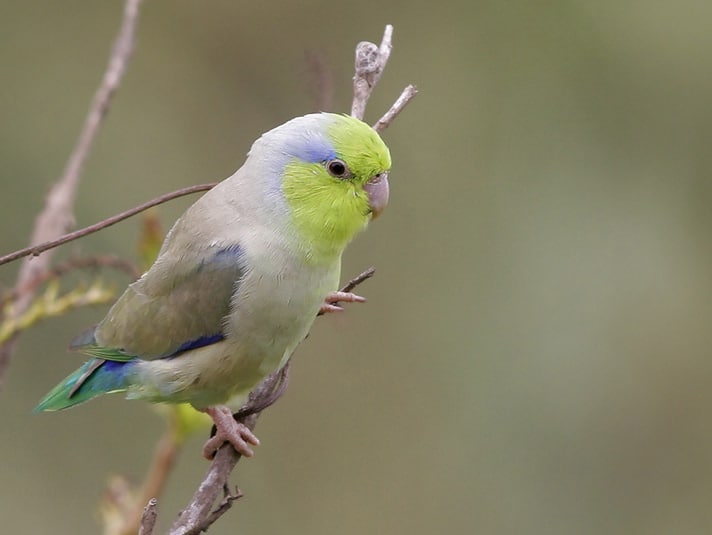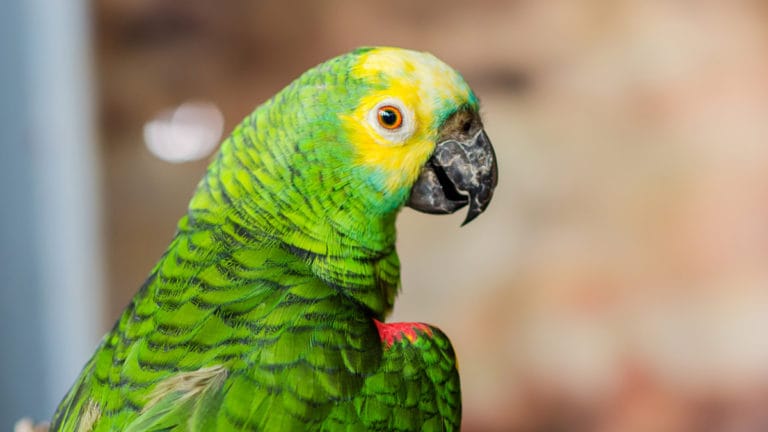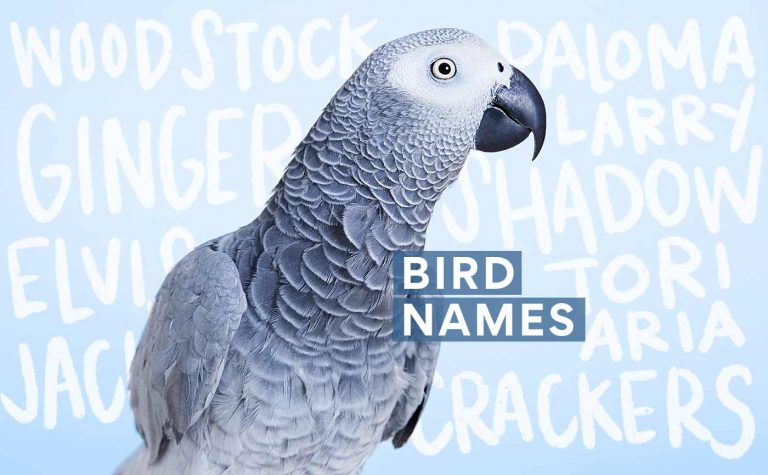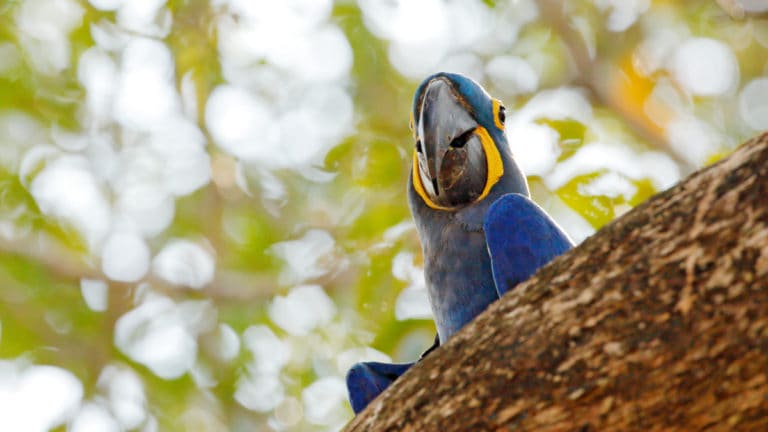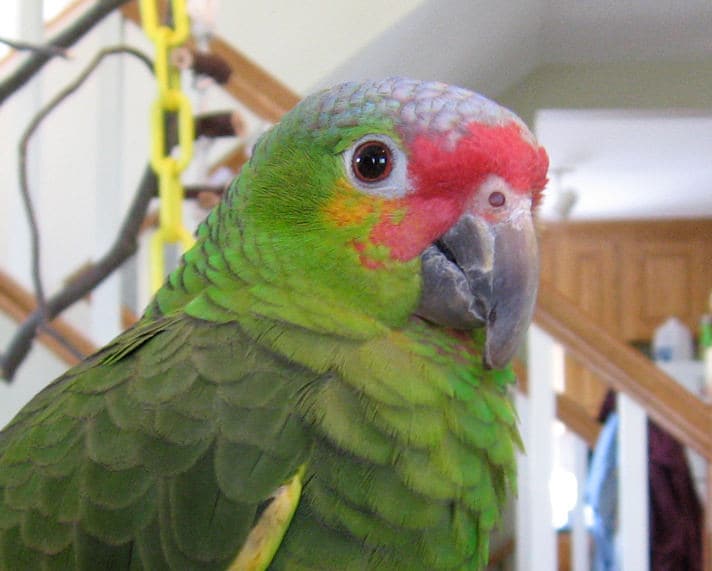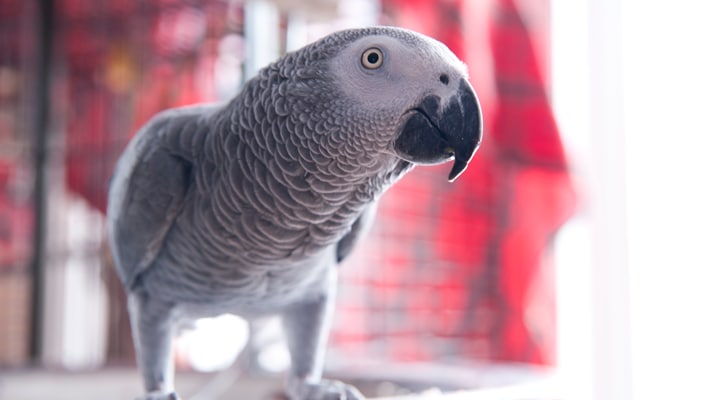Parrotlets, affectionately known as “pocket parrots,” are charming, miniature-sized, true parrots. There are seven species of parrotlets: blue-winged parrotlets (Forpus xanthopterygius), Guiana or green-rumped parrotlets (F. passerinus), Mexican parrotlets (F. cyanopygius), Pacific or Celestial parrotlets (F. coelestis), Sclater’s parrotlets (F. sclateri), spectacled parrotlets (F. conpicillatus) and yellow-faced parrotlets (F. xanthops). The most commonly kept parrotlets in the United States are the green-rumped, Pacific and the spectacled. These usually weigh between 18 and 28 grams and are approximately 3 to 5 1/2 inches in length. Parrotlets can be sexed at a glance, since they are sexually dimorphic. Most owners describe them as lovable and easily maintained, yet very territorial. They are relatively inexpensive at prices ranging from $100 to $350 each. The following are a few common questions one may have while considering a parrotlet for a pet.
1. Are parrotlets loud or relatively quiet?
They are relatively quiet. In fact, Sandee Molenda, a certified avian specialist through the Pet Industry Joint Advisory Council (PIJAC), exclusive parrotlet breeder since 1986 and cofounder of the International Parrotlet Society (IPS), states that “Parrotlets are the quietest hookbills they make. They cannot scream and do not squawk. They chirp and can, at times, have loud chirps, but even my canary is louder. They are much quieter than even budgies and cockatiels.” This bird would make the perfect parrot for someone who lives in an apartment or who doesn’t care for loud noise.
2. Should parrotlets be housed in an aviary or a cage?
Parrotlets demonstrate very aggressive behavior; therefore it is not advisable to keep them with other birds. “They can be kept in a cage or an aviary,” says Darlene Fitchet, a 12-year breeder of parrotlets, member and current president of the IPS and director of Liberty Wildlife (a rehabilitation and education center in Scottsdale, Arizona). “I have a large mixed aviary outside, and I do have one pair of parrotlets in there. Of course, it depends on the other kinds of birds housed in the mixed aviary. Some of my breeder birds are in aviary-sized cages. You can only keep one pair of birds per enclosure.” Caution should be used when mixing parrotlets with other smaller species of birds, and they should have fairly large enclosure — especially when nesting.
3. What are the necessary cage requirements for parrotlets?
The larger the cage, the happier the parrotlet will be. Birds should at least have a cage large enough to allow them to fully extend their wings, without getting their wing feathers caught on the sides or touching their tail feathers against the bottom grill. Fitchet recommends a cage that is 24 by 18 by 18 inches. “You need room for a lot of toys. A swing is a must. … Toys are an important part of any pet’s cage or breeder’s cage.” Parrotlets spend much of their time entertaining themselves with toys but also seem to enjoy snuggling up to their owners. Always use safe toys, such as those without small movable parts, wire or string.
4. What type of diet is the healthiest for a parrotlet?
A varied diet of seed, pellets, fruits and vegetables is the healthiest diet for parrotlets. According to April Winger, breeder of parrotlets for seven years, a certified avian specialist through the PIJAC program and member of both the IPS and American Federation of Aviculture (AFA), the diet should consist of “cockatiel seed that includes black oiled sunflower seeds, and these birds need fresh veggies and fruits if you want a healthy sheen to them.” She also adds, “I have found that they are much more inclined to eat fresh foods if their food is minced small; they tend to back off a vegetable that is half their size.”
5. Are parrotlets temperamental, and/or do they bite?
Most parrots bite on occasion. “They can be temperamental at molting and during hormonal temperatures, but it’s not horrific and very manageable,” says Winger. Many birds can be trained not to bite. Although training is easier with a newly weaned baby rather than an adult bird, hope is never lost with proper care and guidance.
6. What are some parrotlet health concerns?
As with all pets, pet birds should have annual checkups. Birds are known to hide their distress, so an avian veterinarian should see them regularly.
“Parrotlets that are kept in clean conditions, fed well and not exposed to other birds, should live a good long time (20 to 30 years),” Molenda advises. “Most typically, they can get simple bacterial or yeast infections but no more so than any other bird. It is believed that they are resistant to polyomavirus, but not immune.”
She also adds that, “Recently, some parrotlets have been diagnosed with a fungus called megabacteria, which is commonly found in many other species of birds. Not much is known about the fungus including whether or not it is truly a pathogen that causes disease. It is diagnosable and treatable. Moreover, Texas A&M University is currently conducting research on megabacteria and the International Parrotlet Society is conducting a fund-raising campaign for this research.”
7. Is it best to get only one, or should they be kept as a pair?
“Pet birds should be kept as single birds. If you have two birds, they tend to bond with each other, and they don’t need you as much. Single birds want you to be their best friend. They look forward to coming out of the cage to be with you,” notes Fitchet. Parrotlets are said to be aggressive toward other birds and unless they are breeder birds, only one is best per cage. Keep in mind that they can be aggressive toward their young as well, therefore, take caution and consult a parrotlet expert when attempting to breed them.
8. Can parrotlets talk?
The more time spent with your parrotlet, the better behaved they become and the more they will learn to mimic speech. “According to the IPS survey taken every year, about 80 percent of the males and about 20 percent of the females kept as pets talk,” says Molenda. Some learn to say a few words, and others learn to say many words and phrases.
9. Do parrotlets need a lot of attention?
Birds, like most pets, thrive on attention, so they will appreciate all the time you can possibly spend with them. “I believe that they need 15 minutes of one-on-one attention at least two or three times a day,” states Hatchet. She also mentions that, “The cage should be kept in the family room or near the kitchen, because they like to be around people and see what’s going on.”
10. What is the history of parrotlets?
Molenda states that when she started breeding parrotlets in the U.S. back in 1983 she was told that they are “impossible to breed, cannibalistic to mates, destroy eggs, kill babies and [she would be] crazy to consider hand-feeding them and making them into pets.” We now know that even though parrotlets are somewhat aggressive, these myths were unfounded. “The first recorded breeding of parrotlets in the U.S. was in the 1920s and 1930s. Unfortunately, they were difficult to keep in quarantine stations due to their aggressive natures, so many importers declined to deal with them,” says Molenda. Parrotlets have been sighted in Central and South America, mostly in Colombia, Ecuador, northwestern Mexico, Panama and Peru.
11. What should a new parotlet owner expect?
“The new owner should expect an active bird that bonds very quickly, and a bird that will be entertaining, lovable, fearless and a wonderful companion. These birds are small enough to travel with, they seem adaptable to most situations and are fun to watch as well as handle,” Hatchet advises.
Whatever type of parrotlet you choose, make sure that you have its place well-prepared in the home before the new addition arrives. Also, it is very important to research any species of bird that you are attempting to acquire in order to fully understand its personality. The species must suit not only your home and lifestyle, but any current pets and family members in order for your household to be completely satisfied with the new arrival.
Tips To Follow Before Your New Parrotlet Arrives
- Research the bird species by reading books and magazines or by accessing the Internet. Many sites are available about parrotlets, including the International Parrotlet Society.
- Buy the largest cage possible and have the cage set up prior to bringing the bird home. Purchase a travel carrier in order to ensure a safe trip for the bird on its way to the new home and for future trips to the veterinarian.
- Talk to all family members, especially young children, about caring for and feeding the bird. Most children will enjoy active participation with the new pet, such as helping with food preparation. This is a great way to get them involved and teach them about the responsibility of pet ownership.
- Bring the bird home on a weekend, preferably not a holiday weekend where there may be great excitability and more people than usual in the home. It can cause the bird unnecessary anxiety during a traumatic transition.
- Give the bird time to get used to its new cage and surroundings. Children can be especially excited and want to constantly play with a new pet. Inform children that the bird needs time alone in order to adjust to its new environment.
- Find a good avian veterinarian in your area for regular check-ups as well as any emergencies that may arise. You will want to see an avian vet for the bird’s first health examination. The breeder may have the name of a veterinarian in your area, or you may want to ask around to find one that is recommended by friends or family.
Parrotlet Owners’ Brag Quotes
“Kerly is a good talker, likes to cuddle and is sweet-natured and very playful. I haven’t found any negatives.” Carol Gillertson, Illinois — about her 9-month-old Pacific blue parrotlet.
“I chose a bird based on recommendations of friends and a local bird breeder/dealer. I also did extensive research with books and on the Web. The positives include small size, very quiet, not too shy and friendly. The negatives are that it likes to bite and fly, even after multiple wing clippings.” Don Hoven, New York — about his Pacific parrotlet Ollie.
“They are just like a big parrot shrunk down into a tiny body. Every time I come home or walk in the room, I am the highlight of her day. She starts to sing, chirp and carry on and follows me around the room on the sides of her cage until I come over, talk to her and get her out. If someone is looking for the fun and attitude of a big bird in a tiny little body, I would highly recommend one of these.” Kathe Downs, South Dakota — about her female green-rumped parrotlet Squirt.
“Twinkie is very quiet, but makes the cutest peep and chirp sounds when going to sleep or enjoying a particularly delectable piece of food. He is my first bird, so I didn’t have any idea how interactive birds are. She will snuggle up and sleep in the palm of my hand when it is cold.” Roxane Murray, California — about her spectacled parrotlet.
International Parrotlet Society
The International Parrotlet Society was founded in 1992 by a group of parrotlet owners and breeders to promote the proper care, breeding, exhibition and conservation of parrotlets. IPS’s first meeting was held at the American Federation of Aviculture convention in Miami during August of 1992.
IPS now has more than 700 members in 13 different countries and is one of the largest specialty organizations in the world. IPS is affiliated with many avicultural organizations including the American Federation of Aviculture, Society of Parrot Breeders and Exhibitors, Bird Clubs of America and the North American Parrot Society.
Members receive a bimonthly newsletter produced by parrotlet owners and breeders with help from veterinarians, researchers and conservationists. Each issue is broken down into three categories: pet care and training, breeder information and general parrotlet husbandry. Each newsletter contains a color photograph of a different species or color mutation parrotlet. Classified advertising is free to members.
IPS members also receive and can be listed in a membership/breeder directory at no charge. The IPS has a free traceable banding system that allows members to trace birds back to their original ownership with the information reported in the newsletter. IPS sponsors cooperative breeding programs for rare species of parrotlets. Members meet twice a year at the American Federation of Aviculture convention and the National Cage Bird Show.
Posted By: Chewy Editorial
Featured Image: Via peterdehaas2317/Flickr
Share:
